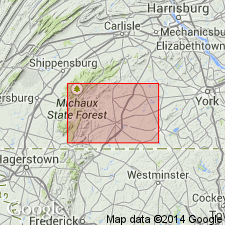
- Usage in publication:
-
- New Oxford formation*
- Modifications:
-
- Named
- Dominant lithology:
-
- Shale
- Sandstone
- Arkose
- Conglomerate
- AAPG geologic province:
-
- Newark basin
Summary:
The New Oxford formation, here named, is the basal unit of the Newark group in the Gettysburg area, Adams Co., PA. It is equivalent to the Stockton formation of Kummel (1896), but is given a new name because the upper limits of the two formations cannot be proved to be the same. It consists of red shale and sandstone with beds of micaceous sandstone, arkose, and conglomerate. The contact with the overlying Gettysburg shale is drawn where harder gray sandstones become less prominent and softer red beds predominate. Thickness of composite section is 6,900 ft. Age is Late Triassic.
Source: GNU records (USGS DDS-6; Reston GNULEX).
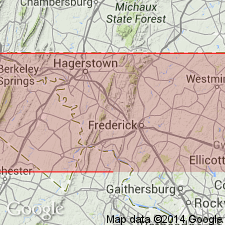
- Usage in publication:
-
- New Oxford formation*
- Modifications:
-
- Areal extent
- AAPG geologic province:
-
- Newark basin
Summary:
The New Oxford formation is extended into the Triassic basins in Frederick County, MD, where map units are red shale and gray to red arkose, basal limestone conglomerate, and basal quartzose conglomerate along the western and eastern borders.
Source: GNU records (USGS DDS-6; Reston GNULEX).
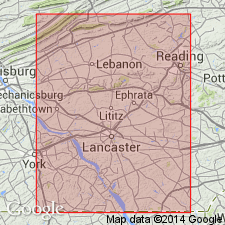
- Usage in publication:
-
- New Oxford lithofacies
- Modifications:
-
- Revised
- AAPG geologic province:
-
- Newark basin
Summary:
The New Oxford Formation of the Newark Group is described as a lithofacies in the area of Lebanon and Lancaster Cos., where the Triassic basin reaches a minimum width of 4 mi.
Source: GNU records (USGS DDS-6; Reston GNULEX).
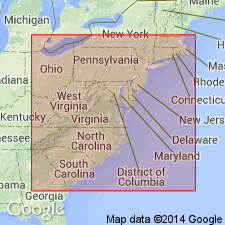
- Usage in publication:
-
- New Oxford Formation
- Modifications:
-
- Biostratigraphic dating
- Age modified
- AAPG geologic province:
-
- Newark basin
Summary:
A late middle and late Carnian age is indicated for the New Oxford Formation, based on palynoflora.
Source: GNU records (USGS DDS-6; Reston GNULEX).
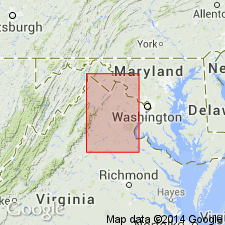
- Usage in publication:
-
- New Oxford Formation*
- Modifications:
-
- Areal extent
Summary:
The name, New Oxford Formation, was extended by Jonas and Stose (1938) into Frederick Co., MD. It is no longer recognized in the area now known as the Culpeper basin, where it is replaced by the Manassas Sandstone and its Poolesville and Tuscarora Creek Members.
Source: GNU records (USGS DDS-6; Reston GNULEX).
For more information, please contact Nancy Stamm, Geologic Names Committee Secretary.
Asterisk (*) indicates published by U.S. Geological Survey authors.
"No current usage" (†) implies that a name has been abandoned or has fallen into disuse. Former usage and, if known, replacement name given in parentheses ( ).
Slash (/) indicates name conflicts with nomenclatural guidelines (CSN, 1933; ACSN, 1961, 1970; NACSN, 1983, 2005, 2021). May be explained within brackets ([ ]).

